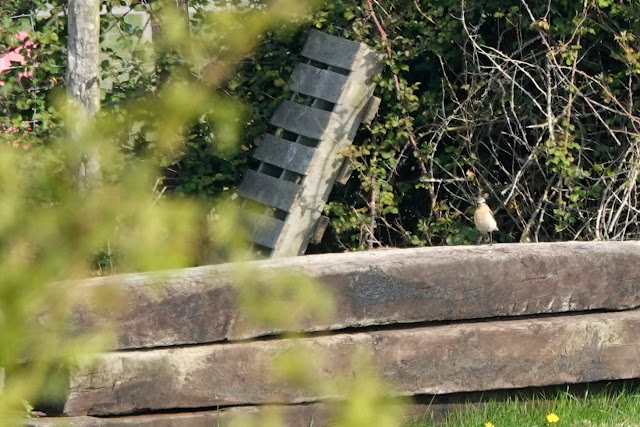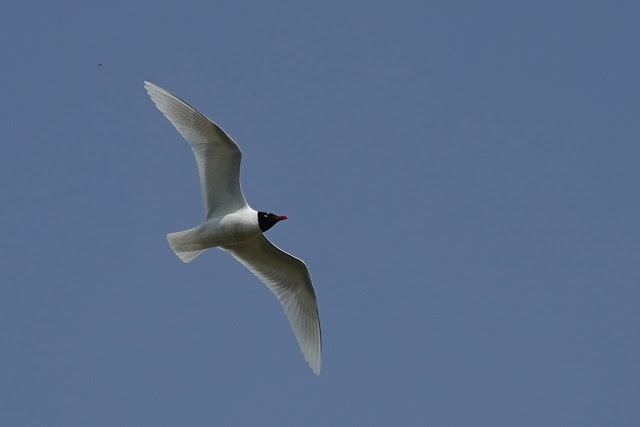Prior to Lockdown I was up at a little after five every
morning to ensure I had a chance of getting to work on time but until last
night I have not set my alarm once since then, allowing myself to wake up
either with a cat nudging me or when my body has had enough of laying down. It
has been a novel experience!
However, I wanted to try and get out early today as it was
due to warm up again for a few days and I had it in my head to see how far I
could get out onto the Isle of Grain before turning back.
I left at six in the chill morning air and headed for town
where I could cut through to Ship Lane passing two London Planes on my way
which were new to the ‘in my head lockdown tree list’.
 |
| London Plane |
The Feral Pigeons on the railway arches gleamed in the
sunshine and I was delighted to hear two singing Skylarks coming from the east
side of the river on the still undeveloped green peninsular. Oystercatchers
were calling noisily and a Common Sandpiper was silhouetted on the receding
shoreline.
 |
| Feral Pigeon |
 |
| Two Skylarks singing over there |
 |
| Common Sandpiper |
The patch of wasteland that I favoured for Little Ringed
Plovers had some puddles on it now but there were just some bathing Herring and
Black-headed Gulls and a drowning traffic cone. I headed up the hill to All Saints
in Frindsbury where the view is becoming greener with every visit and added Lime
to that virtual tree list before following the permitted track onto the patch
of scrub above the quarry where the new development will occur.
 |
| Black-headed Gulls |
 |
| Black-headed Gulls |
 |
| Lime |
 |
| Nice to see some big Elm leaves |
 |
| Woodpigeon on George |
 |
| New Testament Church of God, Strood |
 |
| St Nicholas & NTCoG, in Strood with my house somewhere behind! |
There were still Greenfinches and such like
but it was nice to add several Whitethroats and a Lesser Whitethroat to the
plot. Down the hill to the sewage works with three Swifts above my
head and then on past Gundulph Pool where two pair of Great Crested Grebes were
visible but it looks like all the Tufted Ducks and Pochard have moved on. I was
very pleased to see four Sand Martins here too as this was a species missing
from the walk and garden tally and became number 104.
 |
| Whitethroat |
 |
| Whitethroat |
 |
| MoD Bunneh |
The tide was low again at Upnor which allowed a beach traverse of the
Saxon Shore Way once again. I could hear a Common Tern and eventually it came quite
close but it looked a little odd and despite the light I was convinced that the
bill was all black and that it had smoky grey under parts that left the cheeks
looking shining white. The eastern form longipennis felt like a good call but I
lost it in the glare. Fortunately I picked it up again as I was opposite Hoo
Wood Fort and managed a couple of ridiculously distant shots as it flew in front
of the flats of St Mary’s Island. I
could not really see anything on my camera while out there but once home and on
the pc, the features I saw are visible even at that range. Hopefully someone else on a stroll out will
bump into it.
 |
| Upnor Castle |
 |
| Black-headed Gull |
 |
| The Tern is against the roof! |
 |
| An interesting Tern |
I wended my way through the maze of the boat yards and I
counted at least 18 chirping male House Sparrows en route. I think that they are doing very well in this
part of Kent both in urban and rural settings.
Once up on the river wal I was greeted by two pairs of
Swallows and a Cuckoo calling from where I had one a couple of weeks ago while
another one was out in some scrub on the island with Fort Hoo on the end.
 |
| Fort Hoo |
 |
| Fort Hoo |
 |
| Fort Darnet |
 |
| Oystercatcher |
 |
| Oystercatcher |
 |
| Little Egret |
Whitethroats and Reed Warblers sang along the whole route
and the Skylarks were particularly vociferous. I have still only had one Sedge
Warbler along here which I find odd. I had visions of a Woodchat perched atop a
Hawthorn but was content with some red breasted Linnets and two shouty Cetti’s
Warblers.
 |
| Whitethroat |
 |
| female Linnet |
There were three Wheatears in the paddocks once again but
these were all male Greenlands but they stayed out on the middle.
 |
| Wheatears |
I chose to carry on a little further to check out the piece
of marsh towards Kings North Power Station for the chance that the wet meadows
would hold a Lapwing or two but I alas I am still Lapwingless. I did add another Cuckoo, a good few warblers
and my first two Teal while Rooks and Jackdaws fed with the cattle and a semi-naked man practiced some sort of umm heavy breathing Yoga behind the hedge...
 |
| Kings North Power Station |
Coming off
the seawall took me inland towards the gravel working at the back of Abbots
Pool and almost immediately I found a flighty Wall Brown on the path. This once
common butterfly is now so scarce that it is always a joy to see even one.
 |
| Wall Brown |
Med Gulls drifted over and seemed to be dropping onto the
gravel working with some Black-heads which gave me hope and although I could
not look inside the complex a pair of Little Ringed Plovers did the decent
thing and engaged in several energetic display flight circuits around the invisible
pits. My third new bird for the walk.
 |
| Greylag |
 |
| LRPs! |
Jacobs Lane took me back up towards the Stoke Road with singing
Whitethroats and Skylarks all around. However, I was very disturbed to find a
young man in full protective clothing (but no goggles or facemask) spraying the
entire bank on either side of the road.
I could smell the pesticide on the air and actually stopped
him to ask what he was trying to eradicate suspecting quite correctly that it
was the Alexanders. ‘Targeting this one but not the grass’ was the response. Either side of the lane was sterile Rape. His company truck suggested in their name that they engage in countryside management. I shook my
head in despair and carried on up wind of his rather random spraying.
 |
| Goodbye biodiversity... |
 |
| The view back to the quarry with Fort Dargate behind |
This is the main truck route lorries take in and out of
the aggregate works and the power station so I stayed well on the
verge as I headed up Ropers Lane. A
ditch ran alongside me and was surprisingly rich in flora with great big clumps
of Marsh Marigold and Yellow Flag, Great Willowherb, Celery-leaved Buttercup,
Horsetails and Salad Burnet. There was even a Hairy Hawker patrolling!
 |
| Marsh Marigold |
 |
| Celery Leaved Buttercup |
 |
| Yellow Flag |
 |
| Yellow Flag |
 |
| Salad Burnet |
There were more Skylarks spiralling up and it was good to
find another singing Yellow Wagtail and two more male Corn Buntings jangling merrily. A Peregrine watched from a pylon top and Buzzards thermalled
while four House Martins were collecting mud from a trackside puddle.
 |
| Peregrine |
From here I followed the main road south before turning off
towards Deangate Ridge and into what used to be the golf course and is now Hoo
Country Park. It is a big site and I traversed
the northern side picking up the usual woodland edge suspects before finding a
couple of Nightingales at the far end. I
was aware that the hotly contested Lodge Hill SSSI was just a short way through
the trees where hopefully someone has got in to count the Nightingales this
season to keep up the pressure not to develop the land into yet another little
box, no garden and no nightingale housing complex.
I was told that I could not get out the other end but
unsurprisingly I found a path out to a field margin that took me down to the
new housing development at Chattenden where there were more ‘throats and an out of
place singing Cetti’s Warbler while Med Gulls caught flies above the fields.
 |
| With the Power Station Crane to the left, Hoo St Werburgh church left of centre and the Medway to the right |
 |
| Med Gull |
From here I cut back in again and followed Lochat Road again
through the woods with their Nightingales, Orange Tips and Beeflies before taking a different southerly path than I had before that
took in the rolling sheepfields, a glorious buttercup meadow and even the only
pine plantation I have encountered on my walks.
 |
| Amazing what you find in a middle of a wood |
 |
| Dark-bordered Bee Fly |
 |
| The best camp building I have ever seen! |
I plotted a few more warblers and woodpeckers as I ambled
back past the lettuce, wheat, oilseed and rhubarb fields of Dillywood Lane and eventually to home
after a slightly longer loop than I had anticipated but one with much reward
for my efforts.
A chill out up the garden later on showed that the Swifts
are definitely back now and a male Kestrel, Hobby and a bucket of G’n’T rounded
things up very nicely.
 |
| Swift |
 |
| Hovering male Kestrel... it was a dot in the sky! |





































































Wow that was a good long walk 17 miles. I do enjoy reading your tweets as this brings back memories ask was born and lived in Chatham and remember some of the areas you have visited 👍Martin
ReplyDeletemy pleasure!
DeleteQuite a walk Howard and very interesting, how are you ever going to go back to 'hanging around' Rainham all day after this enforced 'lockdown'?
ReplyDelete